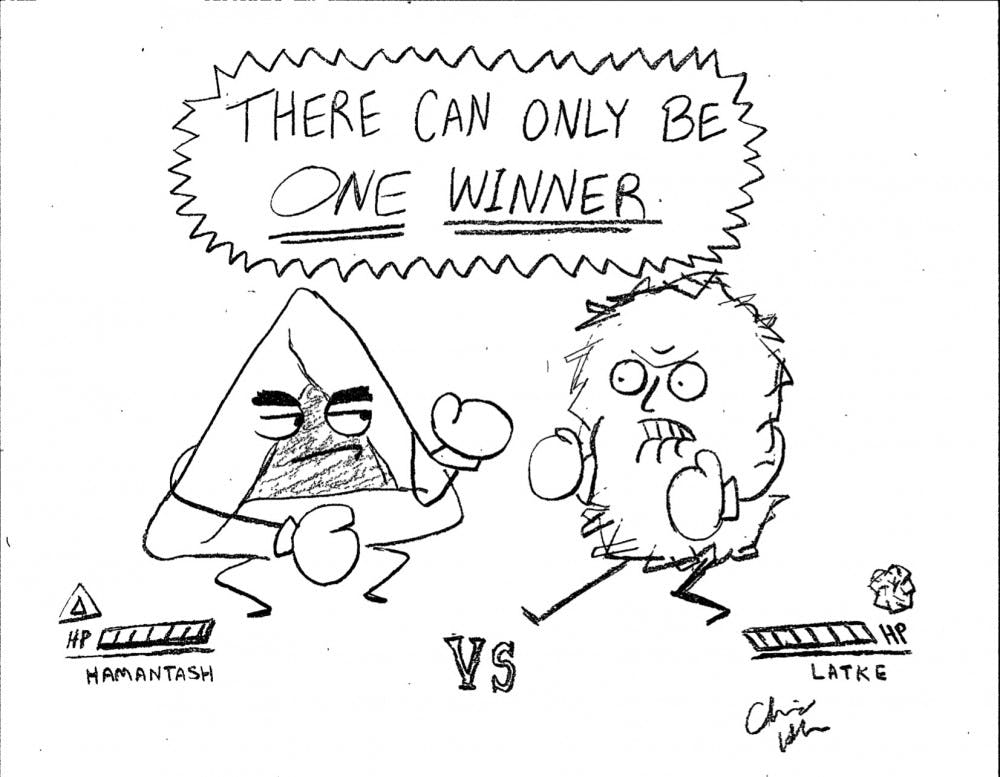It was only fitting that President Christopher Eisgruber ’83 moderated what might safely be called the most contentious debate to ever rage within the Whig Hall Senate chamber. I refer, of course, to the Annual Latke-Hamentaschen Debate.
Originating at the University of Chicago in 1946, this illustrious dispute pits two popular Jewish holiday foods, the latke and the hamentaschen, against one another. The superiority of the latke, a potato pancake traditionally eaten during Hanukkah, is argued for by one team and the primacy of the hamentaschen, a triangular, filled cookie eaten during Purim, is championed by another.
Co-hosted by the American Whig-Cliosophic Society and the Center for Jewish Life on Dec. 3, dozens of students crammed into seats and leaned against walls, anxious to see which holiday treat would reign supreme. Sweet or savory? Triangle or circle? As one concerned audience member asked, filling or schmear?
With Quipfire member Morgan Carmen ’21 and the Department of Public Safety’s very own Sergeant Sean Ryder representing Team Latke and Quipfire member Paul Schorin ’19 and comparative literature professor Leonard Barkan representing Team Hamentaschen, it seemed like anybody’s game.
Carmen took to the podium first — ready to defend the infamous potato pancake under the guise of Schorin’s bubbe (Yiddish lingo for grandmother). Quickly putting on a curly gray wig, wire-rimmed glasses, and a Long Island accent, Carmen spoke to the easy-to-store nature of latkes, the love that goes into their making, and the havoc hamentaschens can wreak on a geriatric digestive system. The compelling argument finished with bubbe Carmen pleading that her grandson Schorin give her a call every once in a while.
Next up to the mic was Barkan. Though his last book “Berlin for Jews: A Twenty-First-Century Companion” apparently included neither latkes nor hamentaschens, he assiduously applied his academic dexterity to the matter at hand. With an expertly crafted PowerPoint, Barkan demonstrated that while subjects of classical portraits were made unattractive by the replacement of their painted hats with latkes, the subjects of the paintings were transformed into bona fide “studs” when their hats were switched with hamentaschens. If seeing is believing, then Team Hamentaschen appeared to be pulling ahead.
Back to Team Latke. Ryder advocated for the miraculous nature of the latke’s origin story and the superior aestheticism of the latke circle to the hamentaschen “brick.” In a particularly dramatic segment of his presentation, a fellow PSAFE officer brought up a secure briefcase containing Schorin’s record. Within this record, Ryder found and displayed irrefutable evidence of Schorin’s own affinity for latkes. Ryder concluded his argument with a quotation to remember: “Potatoes make french fries, chips, and vodka. It’s like the other vegetables aren’t even trying.”
It was up to Schorin to close the debate with one final argument for Team Hamentaschen. An English major with self-professed skills ranging from in-class nail biting to an inability to count, Schorin argued for the supremacy of the hamentaschen primarily on literary and cinematic grounds. Showing images of Robert Pattinson in the “Twilight” series with hamentaschens for fangs and citing a Tracy K. Smith poem as an ode to the cookie, Schorin made a persuasive case for his team while making sure that the entire audience was aware that he is, in fact, on the job market.

Despite the impressive efforts made by both Team Latke and Team Hamentaschen, only one Jewish holiday food emerged victorious. The votes cast by the hungry listeners were clear: The hamentaschen had won. In what may be seen as a conciliatory gesture, however, when latkes and hamentaschens were brought out for those in attendance to eat, audience members and debaters alike happily snacked on both.









